The Tour de France is so much more than a sporting event. It might just be the ultimate tourism ad for all the regions that it visits. Since most of the race takes place in France, it is not surprising that cheese is a big part of the journey. Read on to discover our cheese lover’s guide to the Tour de France 2023.
In this post, we will briefly summarise this year’s stages. And give you a local artisanal cheese recommendation for each day.
SEE ALSO: The Cheese Wanker’s archives of Tour de France guides →
Discover France and its neighbours through the Tour de France
Without a doubt, the Tour de France (or Le Tour as the locals affectionately call it) is the ultimate sporting event where physical prowess meets strategy. In addition to the sporting side of things, the annual race truly shines a spotlight on all the regions that it goes through.
Every year, it inspires millions of viewers around the world to visit the beautiful cities and countryside of France and its neighbouring countries. And one of the biggest draw cards is the local history and food from each city, town and village.
Where Le Tour is going in 2023
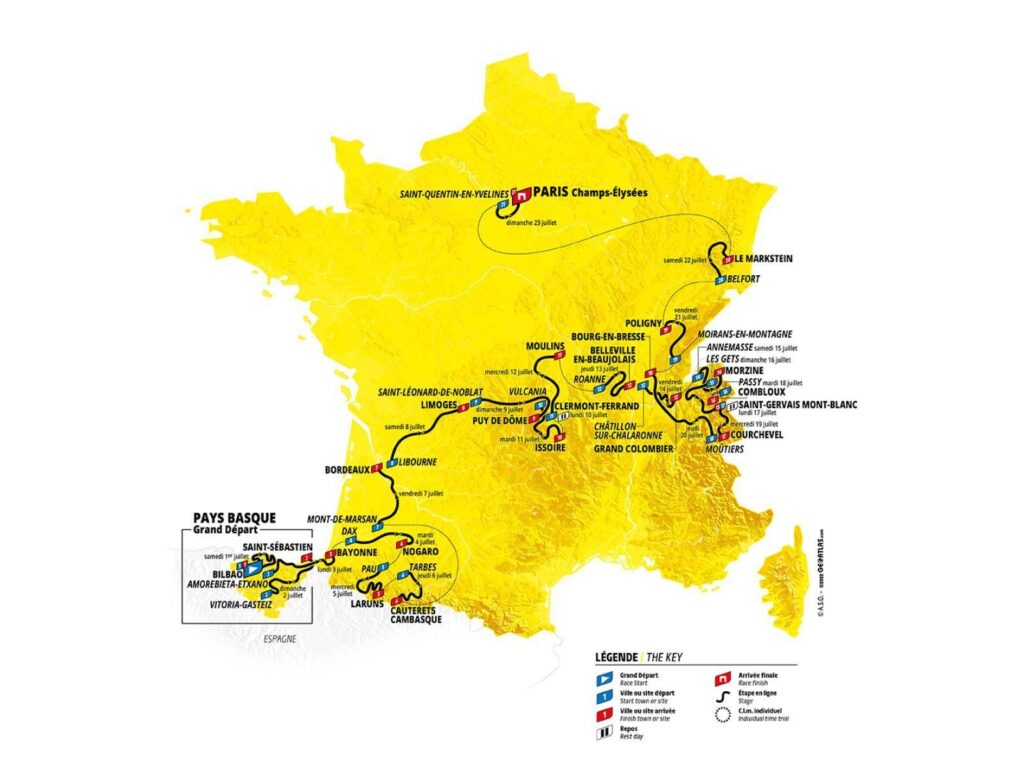
In 2023, the Tour de France will start in Bilbao, Spain on July 1 and end in Paris, France on July 23. It will cover a total distance of 3,404 km and visit all five of France’s mountain ranges: the Pyrénées, the Massif Central, the Jura, the Alps and the Vosges. And the breakdown of the 21 stages will be as follows: 6 flat, 6 hilly, 8 mountain and 1 individual time trial.
For our cheese lover’s guide to the Tour de France, we will give you a local cheese for each stage. Most of them you should be able to purchase in North America and Australia. However, for some of the smaller batch cheeses, you might just have to visit the area yourself to discover them. So, let’s talk cheese!
Stage 1: Bilbao > Bilbao
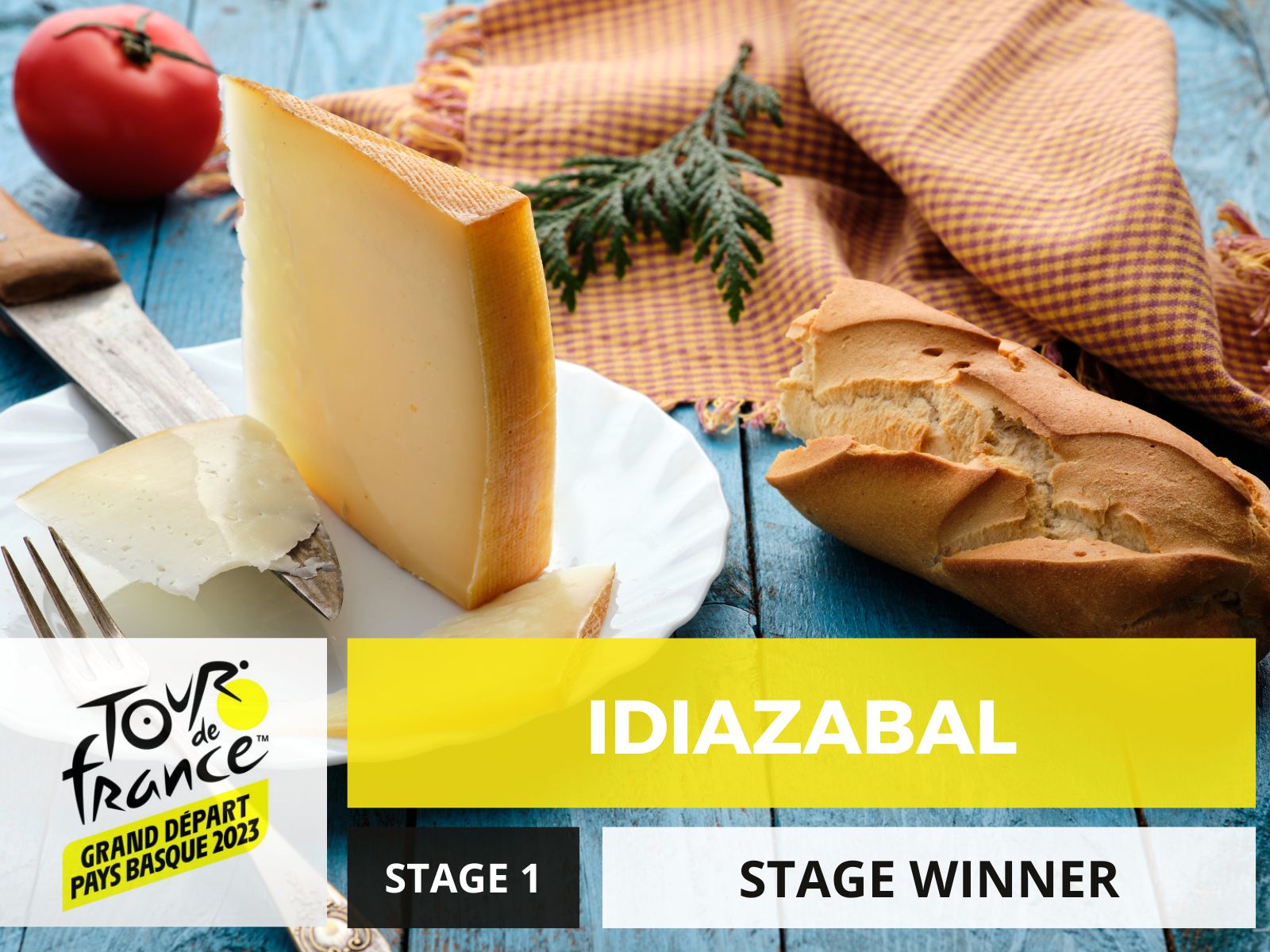
In 2023, the Tour de France kicks off with a medium-mountain stage in Bilbao, Spain. It features five climbs, including the steep Pike Bidea near the end. Undoubtedly, this opening stage will showcase the scenic Basque coastline and countryside.
Within 50 km’s of the city of Bilbao, you will find two of the DOP (Denominación de Origen Protegida) regions for a stunning Basque cheese called Idiazabal.
Idiazabal is a pressed cheese made from raw sheep’s milk. It has a dark brown rind and a pale-yellow paste with a few holes. Overall, this cheese has a nutty, buttery and smoky flavour, as it is sometimes smoked with beech or pine wood.
Idiazabal cheese can be enjoyed on its own or with quince jam, honey or nuts. Moreover, the locals often enjoy it grated over soups or salads. Finally, it pairs well with local red wines, such as Rioja or Navarra.
Stage 2: Vitoria-Gasteiz > San Sebastián
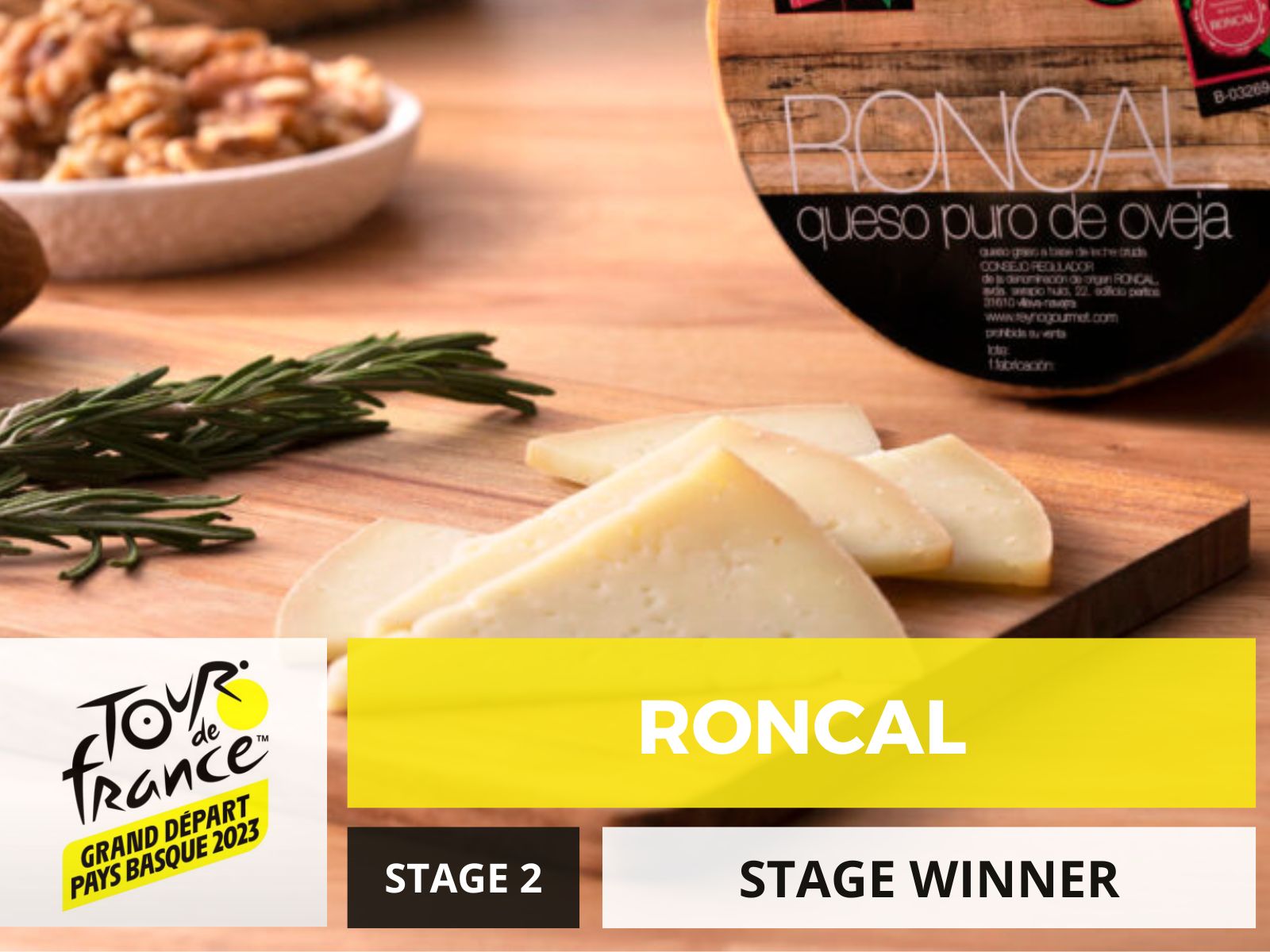
The second stage is another medium-mountain stage that goes from Vitoria-Gasteiz to San Sebastián, Spain. It has five climbs as well, including the famous Jaizkibel. The stage will pass through some of the most iconic towns and landmarks of the Basque region.
Less than 100 kms from the coastal city of San Sebastián, you will find the picturesque Roncal Valley. And this region is home to the aptly named DOP cheese Roncal.
Like Idiazabal, Roncal is a pressed cheese made from raw sheep’s milk. After ageing for 6 months, Roncal develops a complex and pronounced flavour, with hints of lanolin and butterscotch. Moreover, it has a hard, natural rind with patches of blue-grey mould.
The locals like to eat Roncal cheese as a snack or dessert, with bread, fruit or honey. It can also be used in salads, soups or gratins. And just like Idiazabal, it pairs well with local red wines.
Stage 3: Amorebieta-Etxano > Bayonne
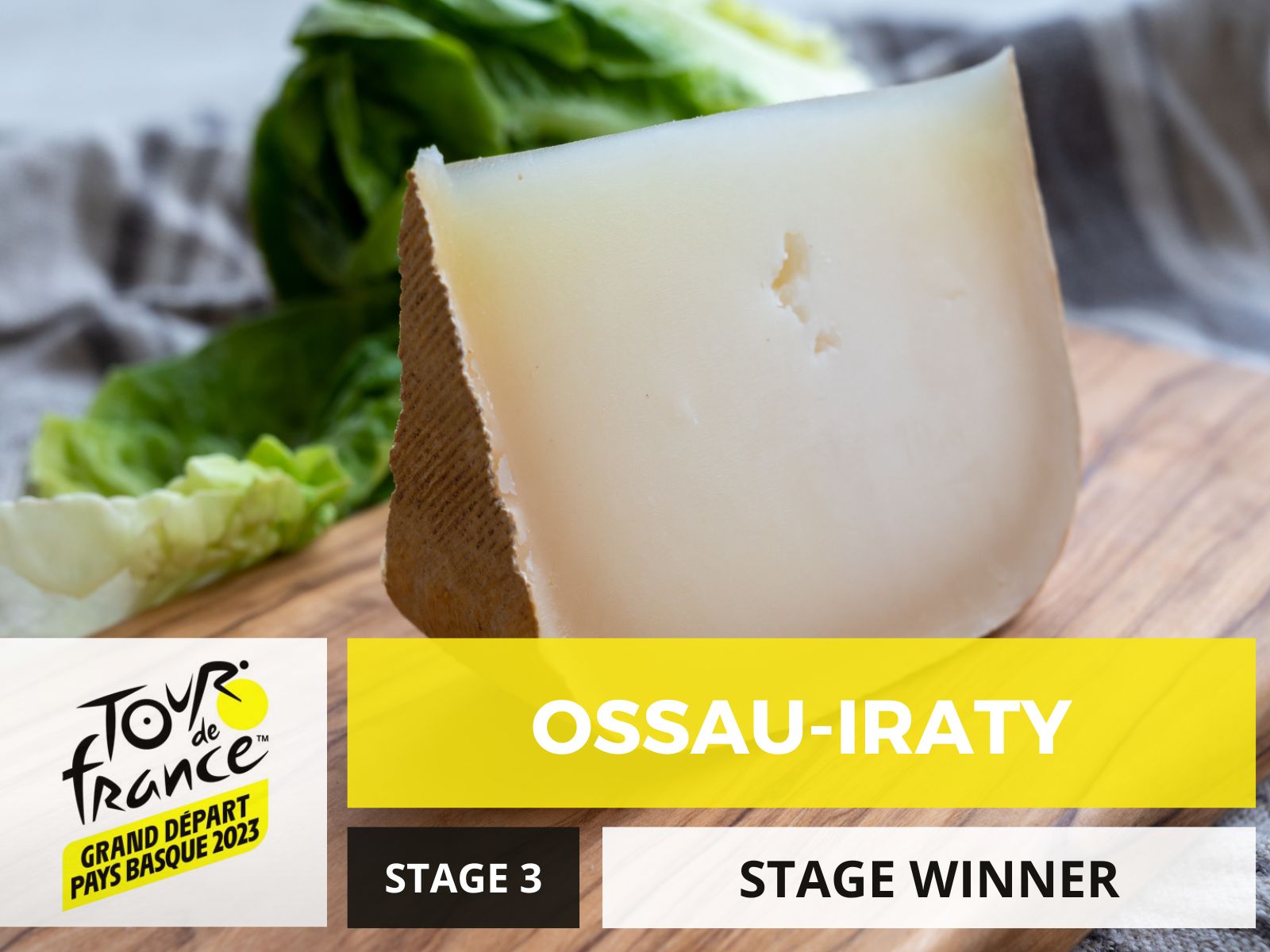
Stage 3 is a flat stage that crosses the border from Amorebieta-Etxano, Spain to Bayonne, France. This should be a fast and furious day for the sprinters, who will have to contend with some crosswinds and narrow roads along the way.
The ville d’arrivée for Stage 3 is within a day’s drive of both the Iraty Forest and the Ossau Valley. So, it is no surprise that our local cheese for this stage is Ossau-Iraty AOP!
You will have noticed a milk trend in the Basque region and Ossau-Iraty is no exception. Indeed, Ossau-Iraty is made from raw sheep’s milk. Wheels of Ossau-Iraty age for at least 80 days and develop a creamy, dense and firm texture. Furthermore, it has a nutty, fruity and herbaceous flavour with a natural rind.
The French Basque people traditionally enjoy this cheese thinly sliced with cherry paste and bread. Unsurprisingly, it also pairs well with local red wines, such as Madiran or Irouléguy.
Stage 4: Dax > Nogaro
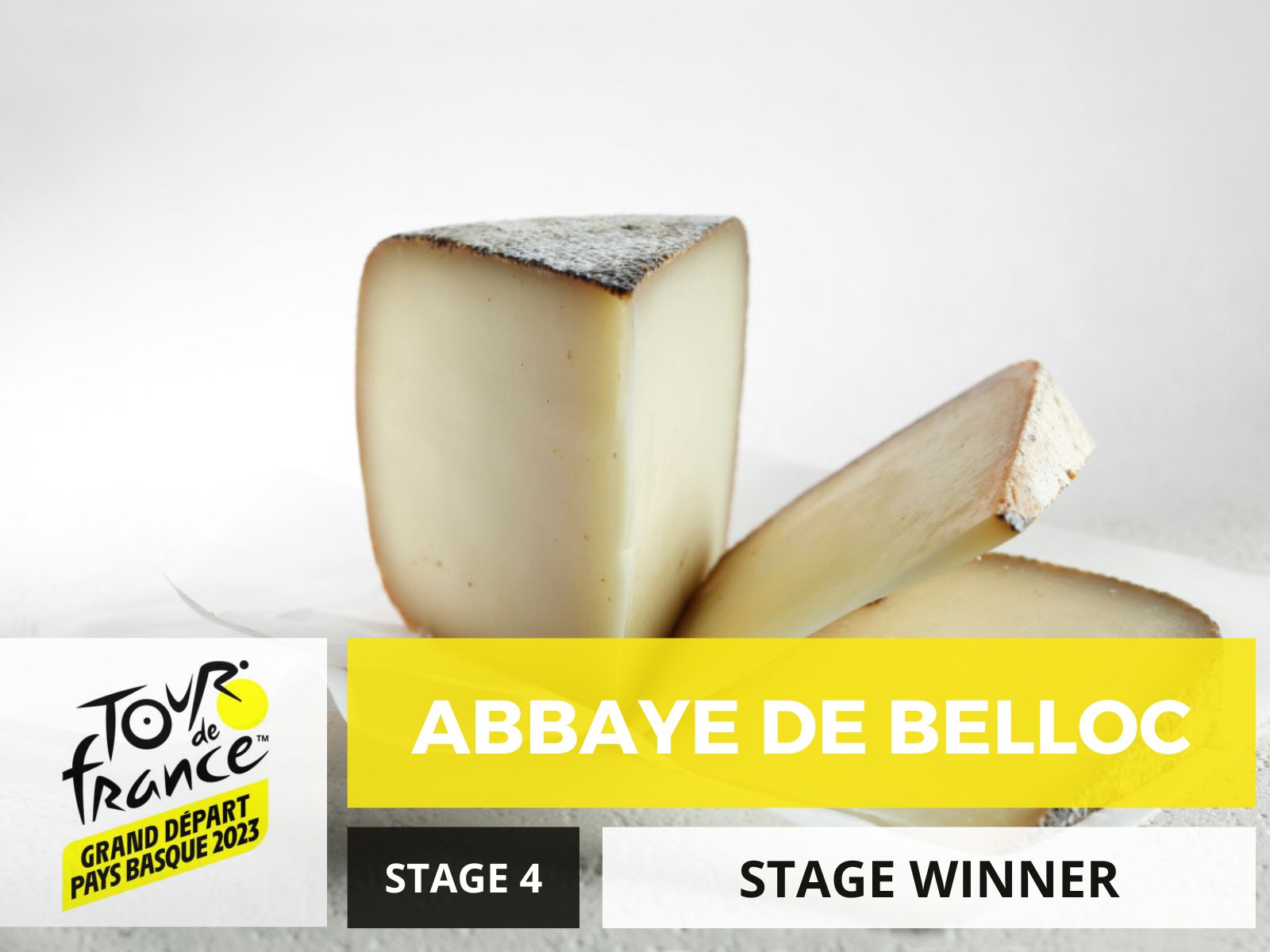
Next, we have another flat stage that goes from Dax to Nogaro Circuit. Again, this will be a chance for the sprinters to shine, as the stage will finish on a motor racing circuit that offers a wide and smooth road.
Our ville de départ, Dax, is within 50 kms of the famous Abbaye Notre-Dame de Belloc. And this abbey was the birthplace of a spectacular eponymous cheese in the 17th century.
Abbaye de Belloc is a semi-hard cheese made from unpasteurised sheep’s milk. It has been made in the abbey by the Benedictine monks for centuries. Wheels of Abbaye de Belloc age for at least four months and have a creamy and dense texture. At that age, they develop a nutty and complex flavour, with a hint of burnt caramel.
Without a doubt, Abbaye de Belloc cheese is good enough to eat on its own. But you can also pair it with bread, fruit or honey. And serve it with a sweet white wine, such as Pacherenc du Vic-Bilh and Sauternes.
Stage 5: Pau > Laruns
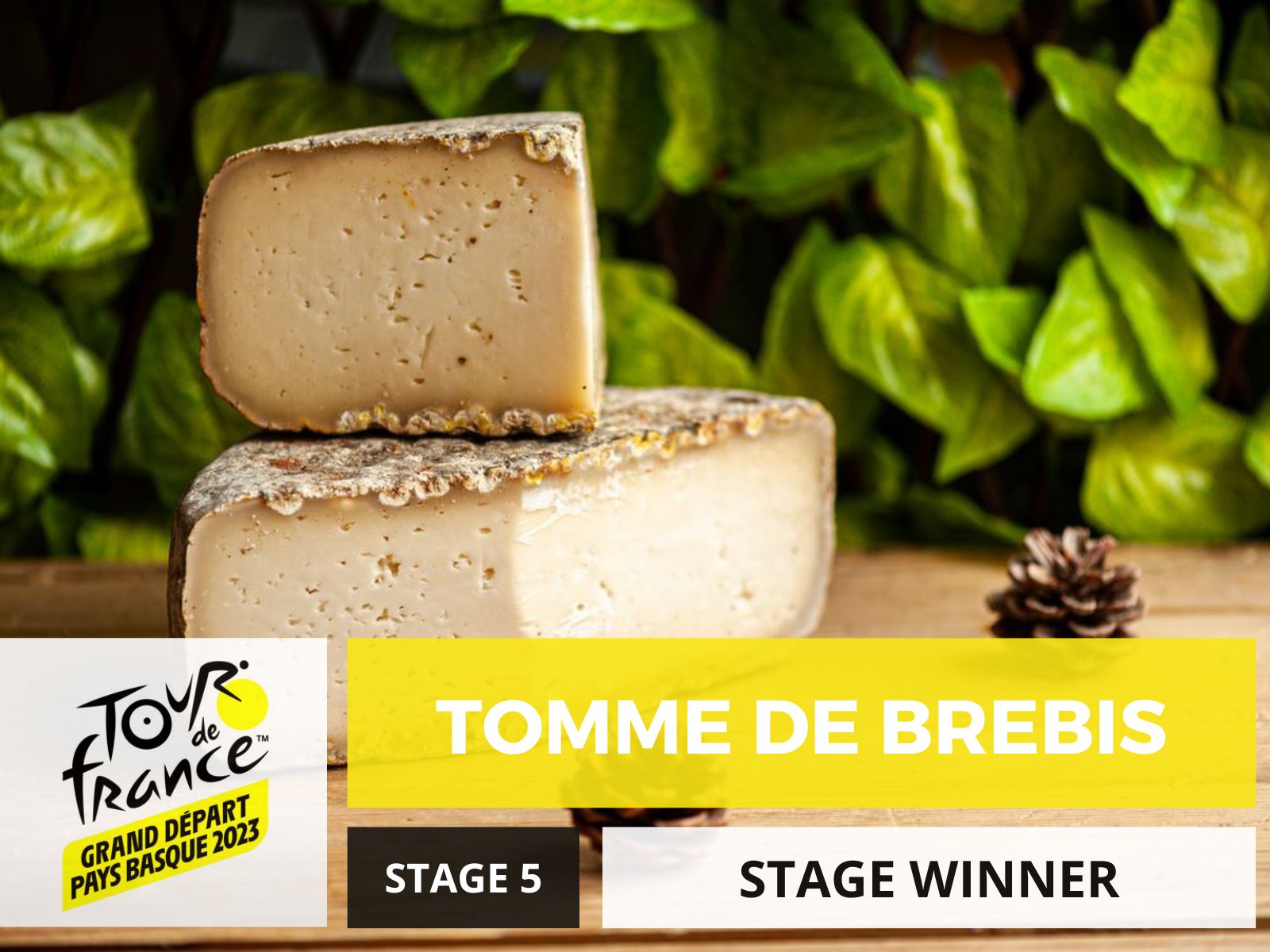
We are already in the Pyrénées! The first mountain stage of the race starts in Pau and finishes in Laruns. Certainly, it will be a challenging day in the Pyrénées, with two major climbs: Col de Soudet and Col de Marie-Blanque. The stage will end with a descent towards Bielle and a flat section where a sprint among the climbers is possible.
Tomme de Brebis is a pressed sheep’s milk cheese that has become very popular around the world. But there is one specific version that we want to recommend for this stage. If you will be in Laruns for Stage 5, look for Régis Carrère-Arrouget’s Tomme de Brebis.
This artisanal cheese has a natural rind that is ochre to brown in colour and an ivory white paste that is smooth and uniform. Overall, its flavour is mild and milky, with a nutty and caramel hint.
Certainly, the best way to enjoy this farmhouse cheese is with black cherries and cherry paste. Also, you can pour yourself a glass of sweet white wine such as AOC Gaillac or Pacherenc du Vic-Bilh.
Stage 6: Tarbes > Cauterets-Cambasque
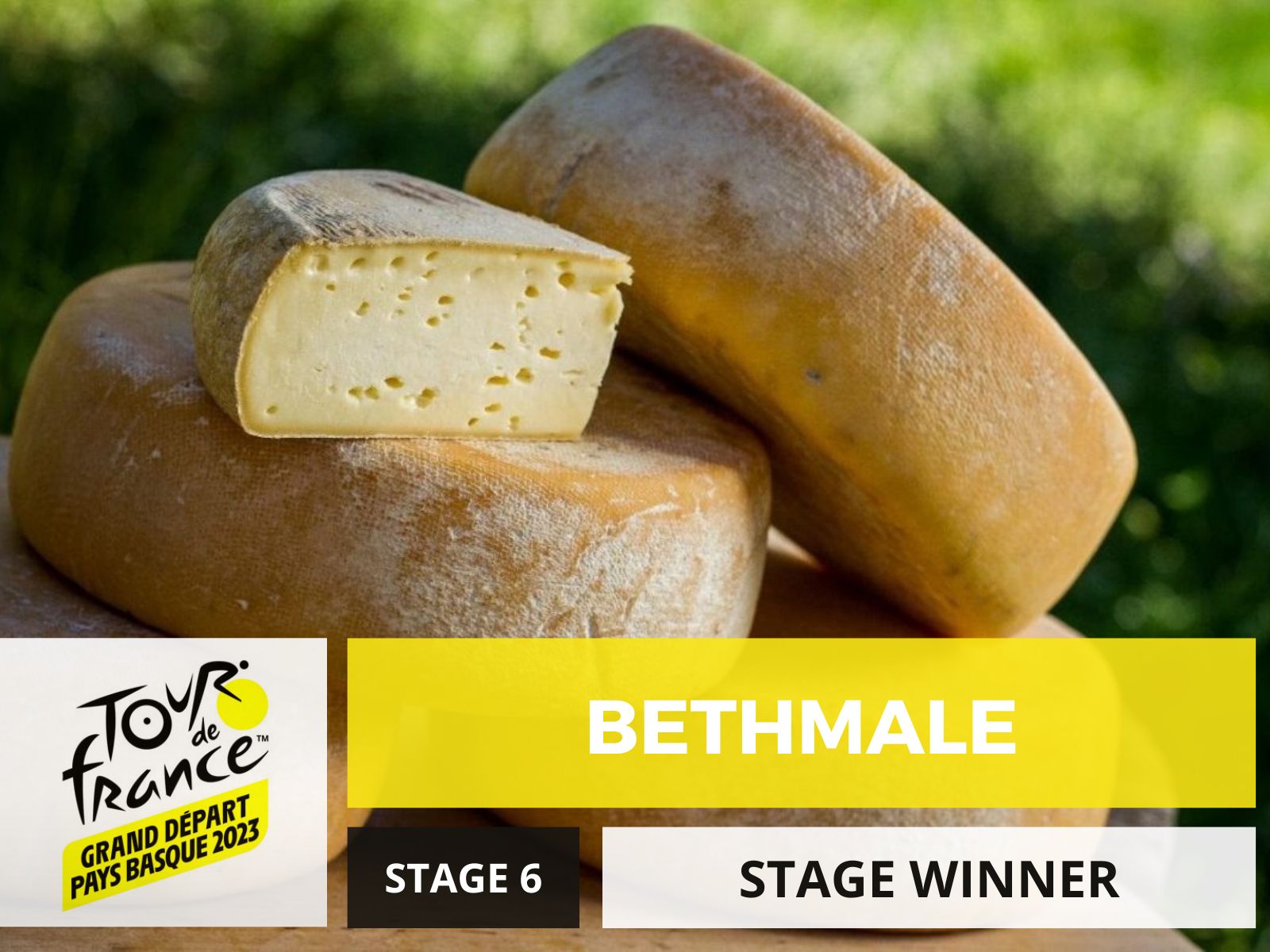
Second day in the Pyrénées as the riders go from Tarbes to Cauterets-Cambasque. This stage will feature three climbs: Col d’Aspin, the legendary Col du Tourmalet and Cauterets-Cambasque. The latter is a summit finish that has never been used before in the Tour. Without a doubt, this steep and irregular climb will test the legs and lungs of the riders.
A beautiful day trip away from Tarbes will get you to the Bethmale valley. This region in the Ariège department is the birthplace of the first cow’s milk cheese on our 2023 list.
Bethmale is a pressed cheese made from raw cow’s milk. Its natural rind is golden and sticky. And it has an ivory or yellow paste that is dotted with small holes. Bethmale has a mild and rich flavour, with earthy and mushroomy notes.
Like the Basque cheeses, Bethmale excels when thinly sliced on a cheese plate. Pair it with cherry paste and a glass of Syrah or Grenache.
Stage 7: Mont-de-Marsan > Bordeaux
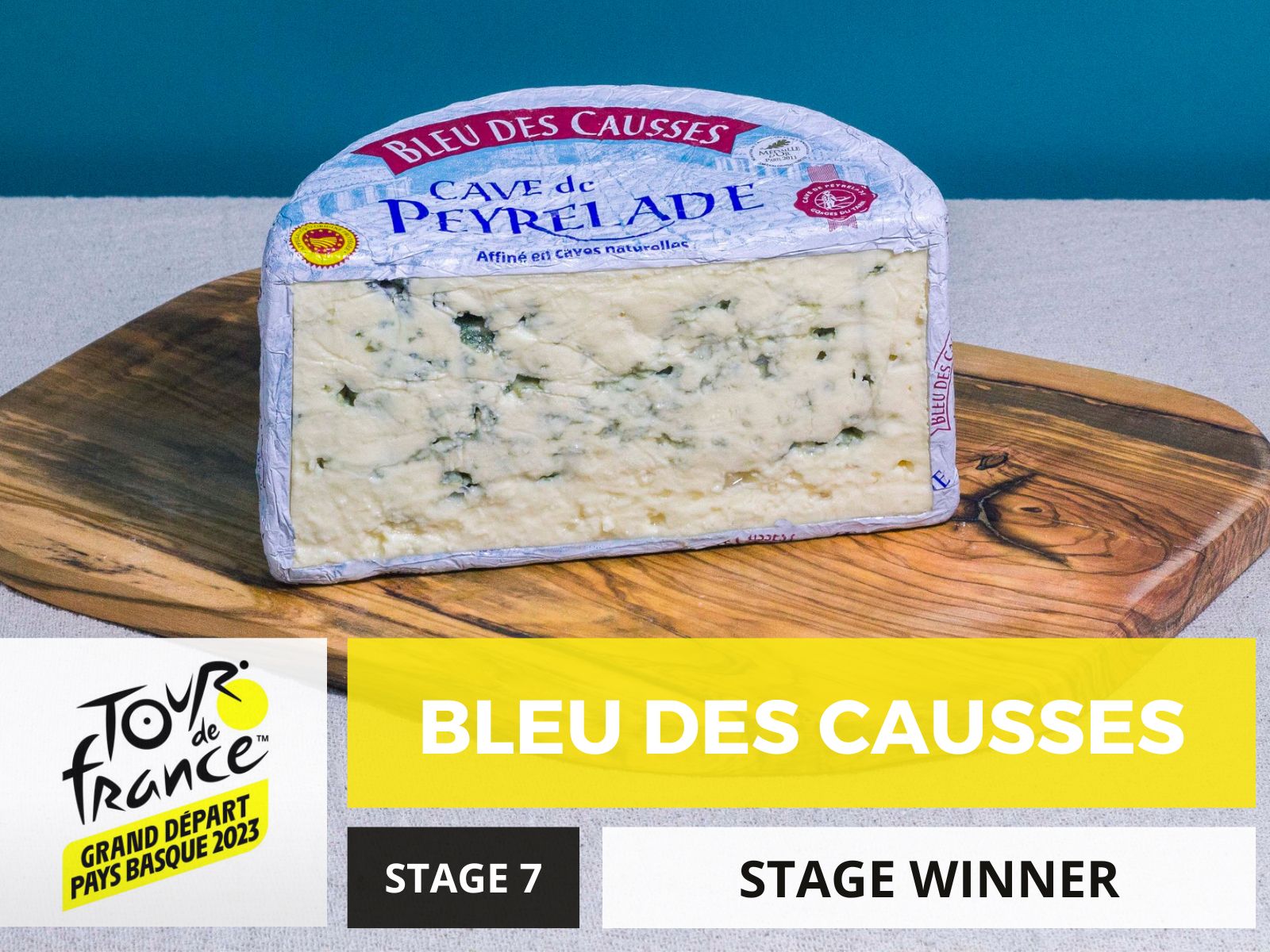
Stage 7 is a flat stage that goes from Mont-de-Marsan to Bordeaux. It will be a welcome relief for the peloton after two hard days in the mountains. The stage will pass through some of the most famous vineyards and châteaux of Bordeaux, and end with a sprint on the banks of the Garonne River.
The nearby Parc des Causses is home to one of France’s most famous cow milk blue cheeses, Bleu des Causses.
Bleu des Causses is aged for 3-6 months in natural limestone caves in Gorges du Tarn, which gives it a special aroma and flavour. Overall, Bleu des Causses has a creamy texture with blue veins and a natural rind that is golden and sticky.
As if often the case with blue cheeses, Bleu des Causses pairs well with sweet accompaniments and beverages. So, my tip is to serve this blue with honey, dark chocolate and a glass of Sauternes.
Stage 8: Libourne > Limoges
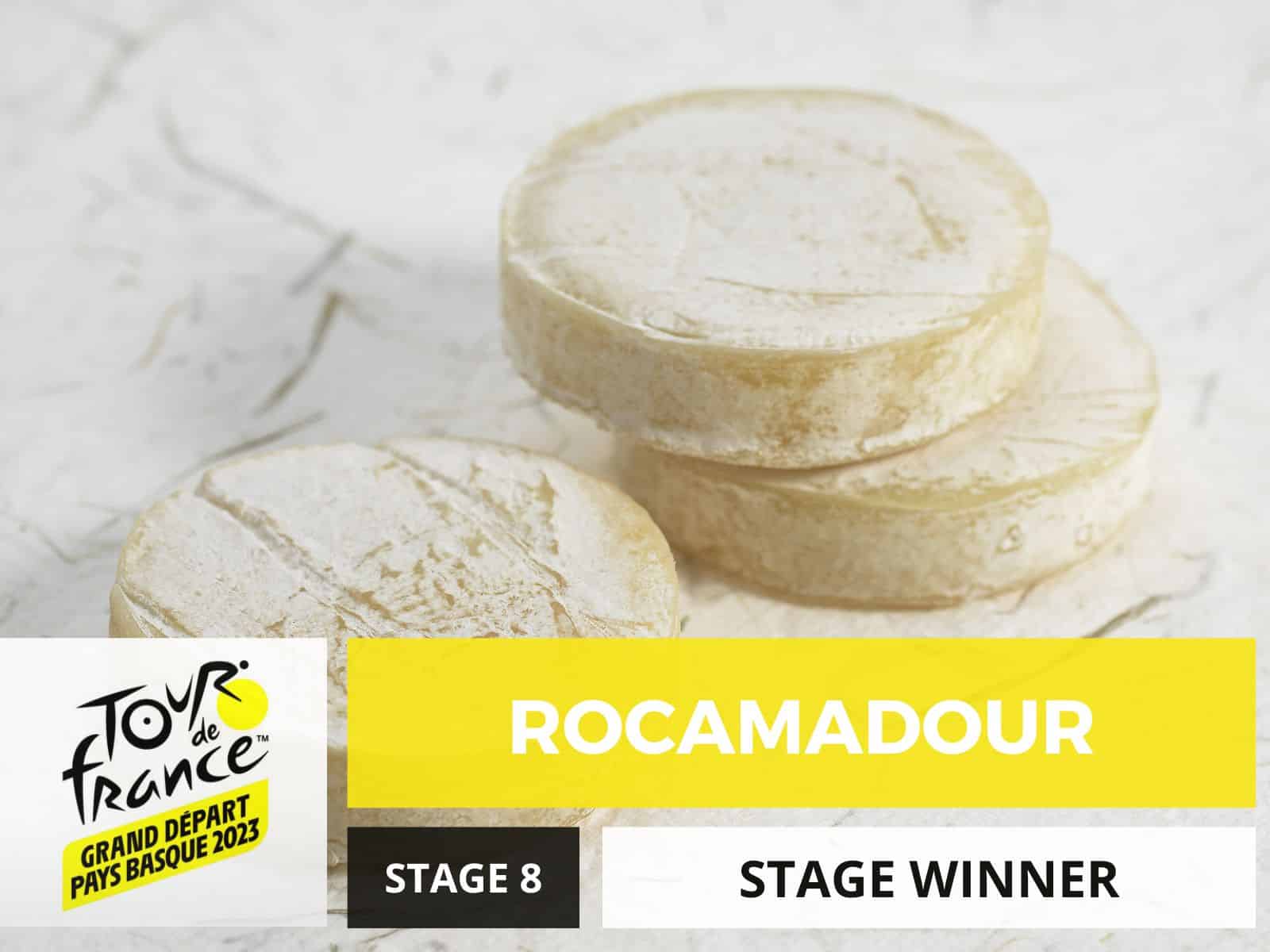
This hilly stage takes us from Libourne to Limoges. It will be a transitional day from the southwest to the centre of France. Today, the stage will have some rolling hills and a few short climbs, but nothing too challenging for the GC (General Classification) contenders.
Today’s route will take the riders within touching distance of the historic town of Rocamadour. And its most famous product, the eponymous AOP goat milk cheese.
Rocamadour is a soft white mould cheese made from unpasteurized goat’s milk in the regions of Périgord and Quercy. It has a nutty, goaty flavour and a velvety rind. As a matter of fact, this tiny round is one of the smallest French cheeses to bear an AOP stamp.
This goat cheese can be eaten young or aged for a stronger taste. The locals enjoy it on hot toast or in a warm goat cheese salad (Salade Chaude).
Stage 9: Saint-Léonard-de-Noblat > Puy de Dôme
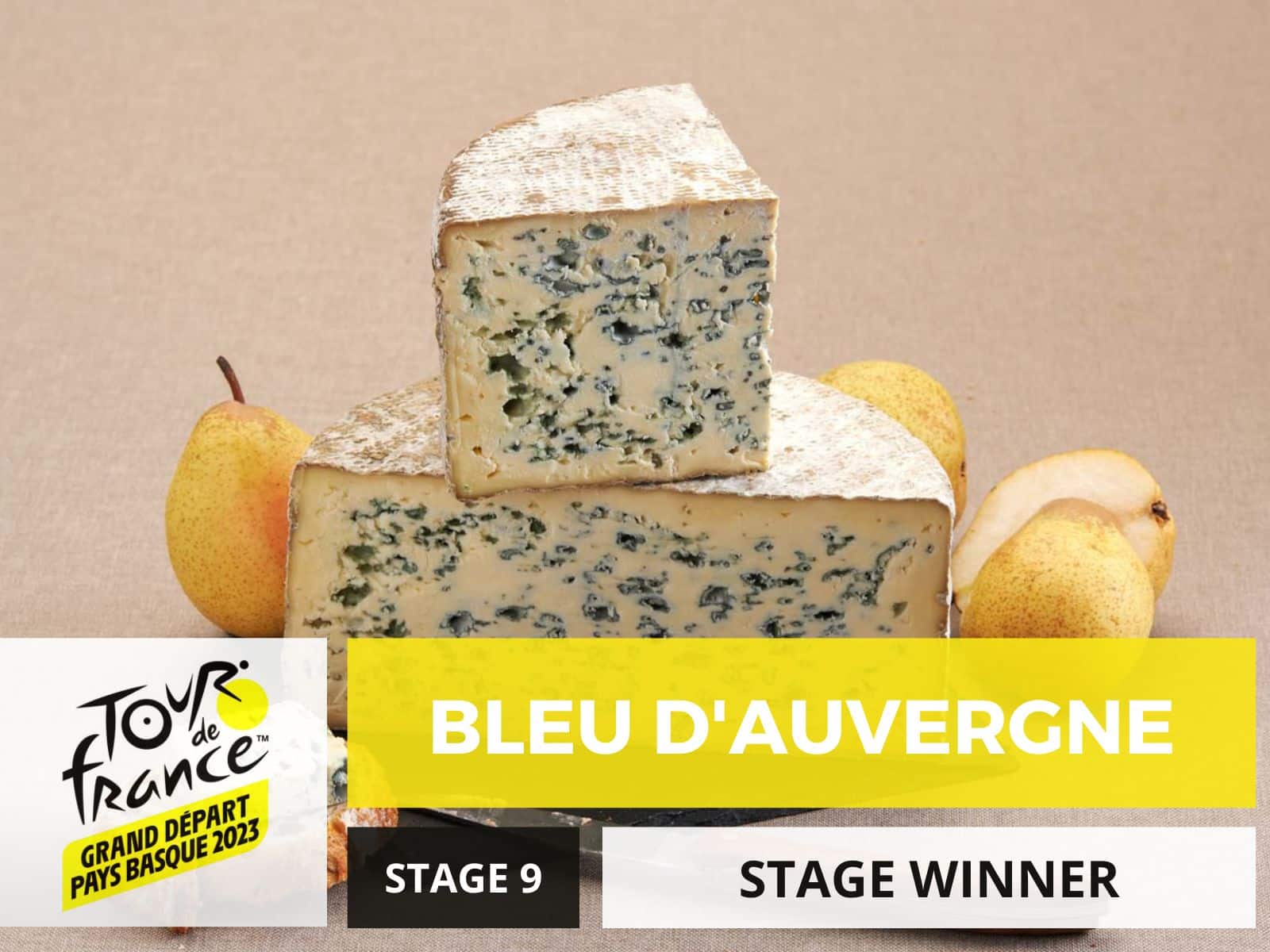
And we’re back in the mountains for Stage 9. Actually, this will be a historic day for the Tour, as it returns to the iconic volcano Puy de Dôme after 35 years of absence. The stage will end with the 13.3 km climb at 7.7% towards Puy de Dôme.
Since we are in the Auvergne-Rhône-Alpes region, we simply cannot avoid the local blue cheese, Bleu d’Auvergne. Indeed, the Puy de Dôme department is in the AOP production zone for this iconic blue cheese.
Bleu d’Auvergne is made from cow’s milk and has a creamy and smooth texture with blue-green veins of mould. Moreover, it has a strong aroma and a buttery, spicy, tangy flavour.
Without a doubt, this cheese is an excellent addition to any cheese board. Having said that, the locals also enjoy it crumbled on top of salads and pasta dishes. Also, it pairs beautifully with a sweet white wine such as Sauternes, green pear and dark chocolate.
Stage 10: Vulcania > Issoire
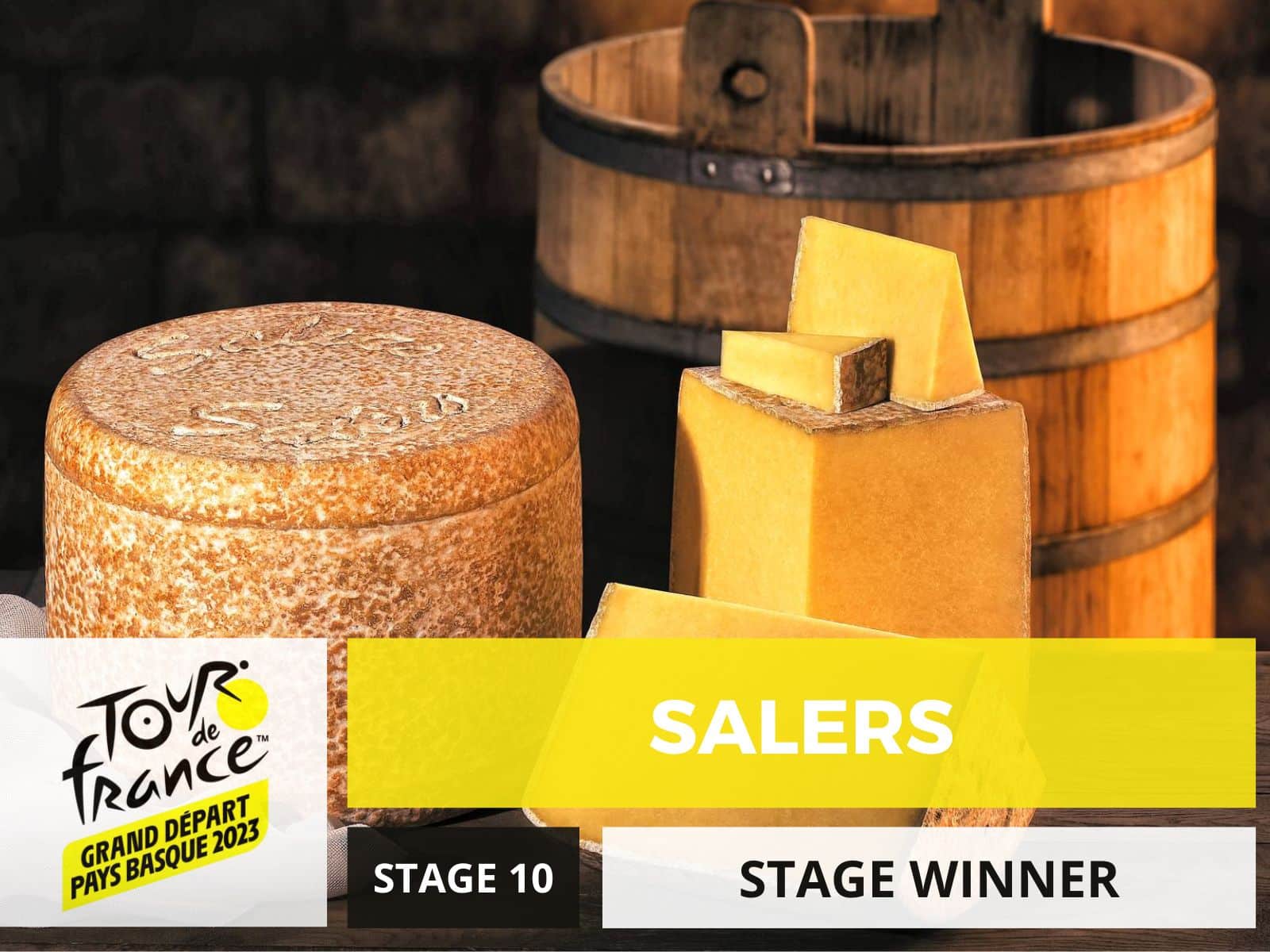
We’re very much in volcano country again today. Stage 10 is a hilly stage that starts from Vulcania, a volcanic theme park, and finishes in Issoire, a town with a Romanesque church. The stage will have some ups and downs and a few minor climbs.
Choosing a single cheese for this stage was really challenging because it is close to so many amazing artisanal cheeses. After a photo finish, we’ve given the win to Salers over Cantal.
Salers cheese is a semi-hard cheese that comes from the Auvergne region. It is made from the raw milk of Salers cows, which graze on mountain pastures in the summer. Salers has a natural brown rind and a yellow interior with a nutty and spicy flavour.
As for pairings, you will want to enjoy Salers cheese with a full-bodied red wine, such as a robust Syrah or a bold Cabernet Sauvignon. Furthermore, the cheese is great with beers such as a Dark Ale or a Stout.
Stage 11: Clermont-Ferrand > Moulins
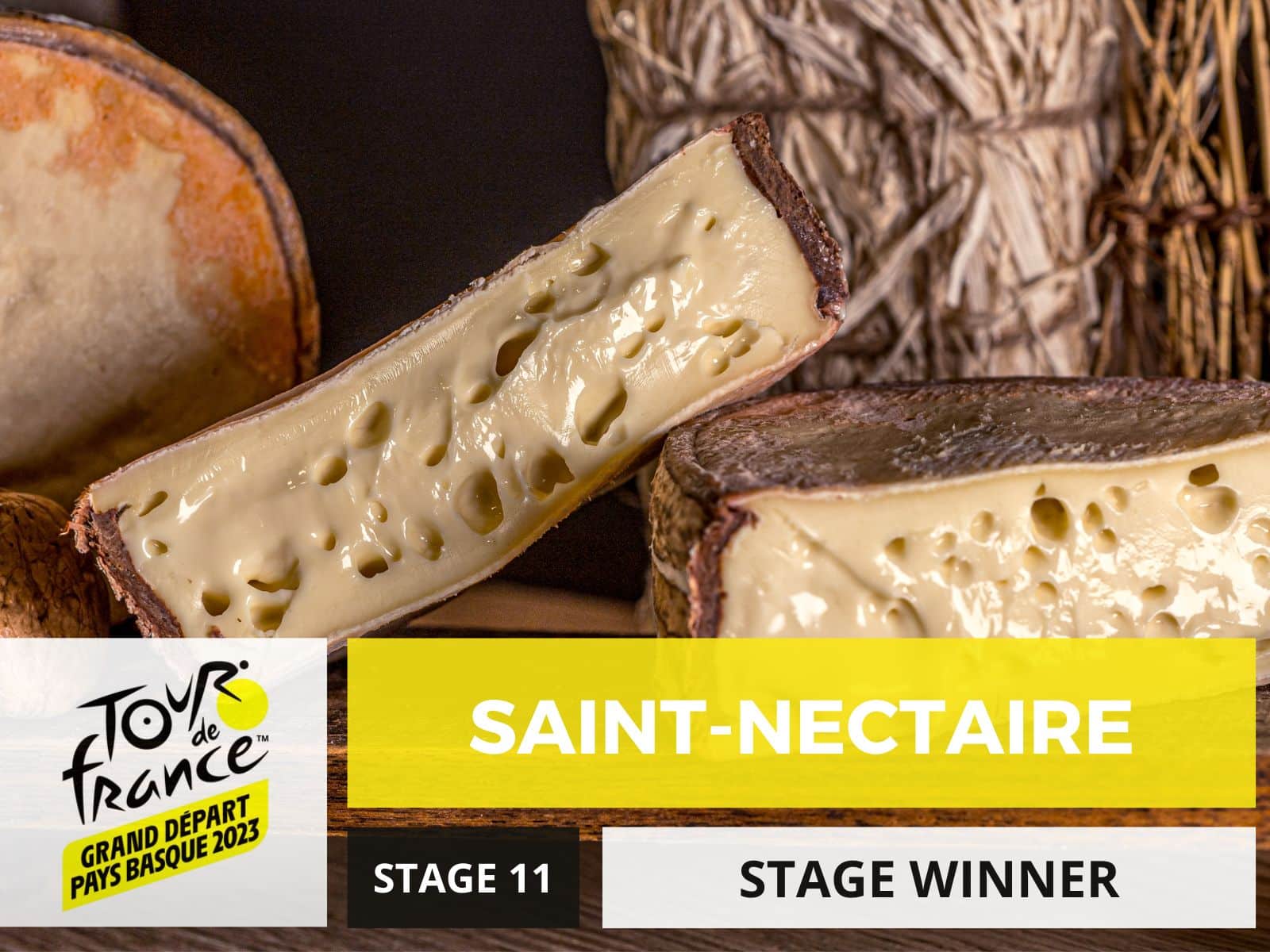
Stage 11 is a flat stage that goes from Clermont-Ferrand to Moulins. In theory, this should be a calm day for the peloton before the next challenges in the mountains. The stage will cross the plains of the Auvergne region and end with a sprint in Moulins, a town known for its art and history.
Our ville de départ is only a stone’s throw away from the historic town of Saint-Nectaire and its iconic cheese.
Saint-Nectaire is a semi-soft cheese that originates from the Auvergne region of central France. It is made from the milk of cows that graze on volcanic pastures. And it has a washed rind with a pungent aroma and an earthy, nutty, mushroomy flavour.
Unsurprisingly, Saint-Nectaire pairs well with equally robust red wines, such as Bordeaux or Shiraz. Or dark beers, such as Ale or Stout. You cabn also serve it with bread, fruit and nuts.
Stage 12: Roanne > Belleville-en-Beaujolais
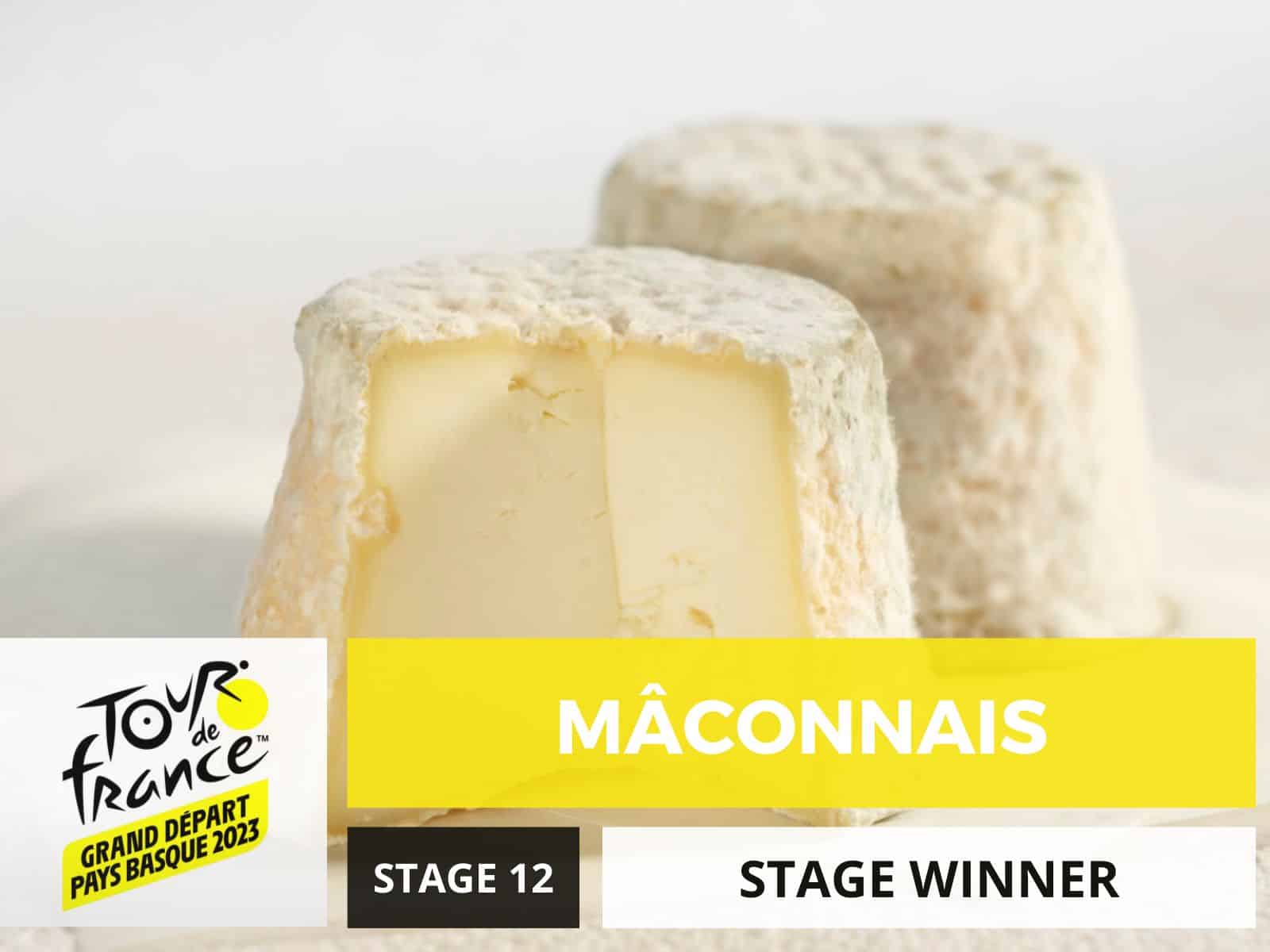
Today we have a hilly stage that will take the riders from Roanne to Belleville-en-Beaujolais. It will be a tricky day for the riders, as they will face some undulating terrain and a few short but steep climbs. The stage will pass through some of the most famous wine-producing areas of France, such as Beaujolais and Mâconnais.
And you’ve probably guessed it. Our winning cheese for this stage is one that shares its name with an AOP wine, Mâconnais. Indeed, our ville d’arrivée is within 30 kms of the birthplace of this goat milk cheese, Mâcon.
Mâconnais is made from goat’s milk or a combination of goat and cow milk. It has a soft, creamy, and smooth texture with a salty and tangy flavour and a herbal aroma. Moreover, it has a bloomy rind that may develop blue marks as it ripens.
No surprises for the pairings here. You simply must enjoy this cheese with a local Beaujolais or Mâconnais white wine. In addition to this, you can also serve Mâconnais cheese with bread and fruit.
Stage 13: Châtillon-sur-Chalaronne > Grand Colombier (FÊTE NATIONALE)
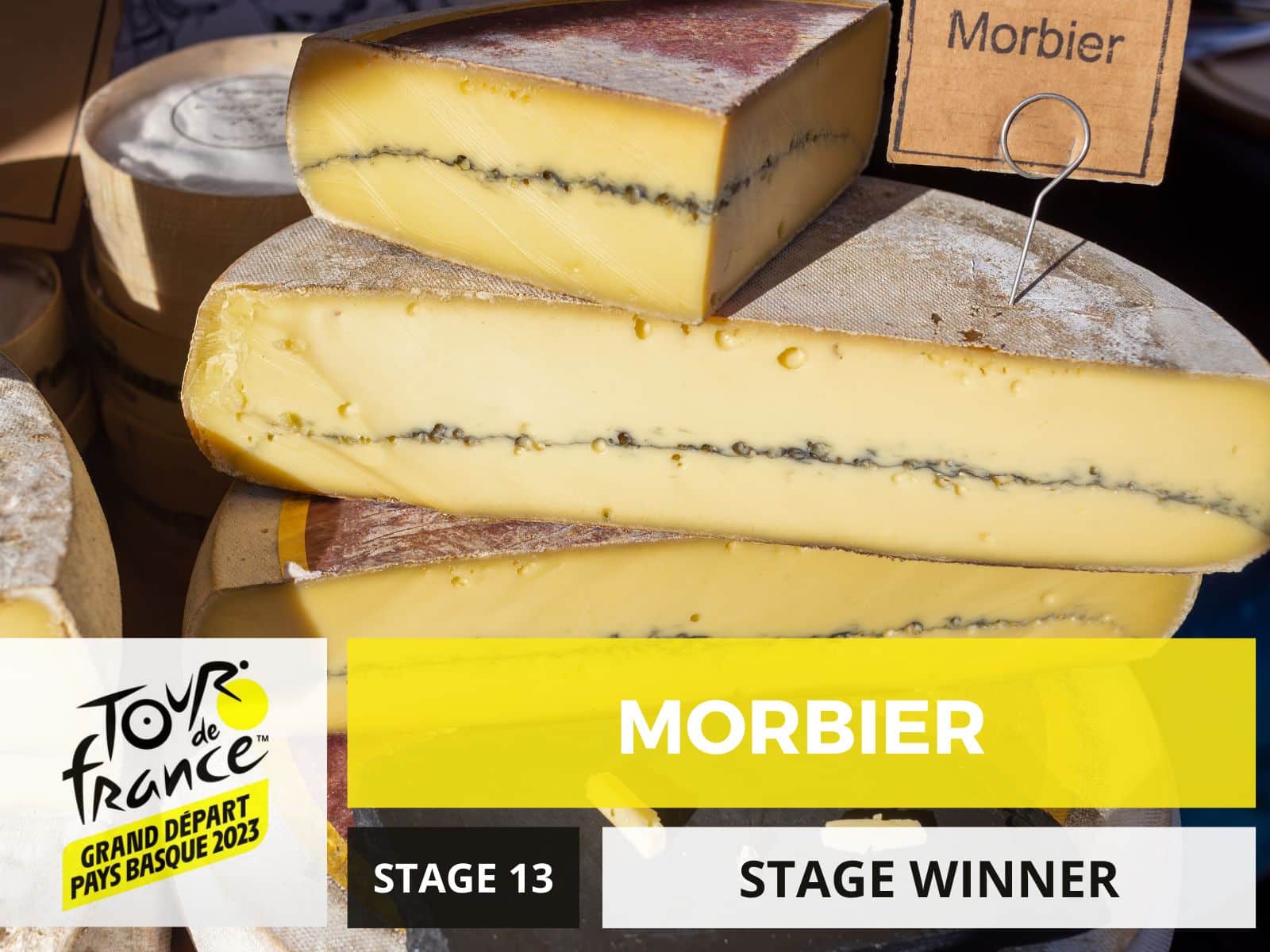
And we’re in the Alps! This mountain stage goes from Châtillon-sur-Chalaronne to Grand Colombier. It will be a decisive day for the GC battle, as it will feature three tough climbs and a finish on top of the Grand Colombier. This stage will fall on the 14th of July, so watch out for the French riders!
The route of Stage 13 will travel through the designated production zone for one of France’s most recognisable cheeses, Morbier.
Morbier is a semi-soft cheese that is made from cow’s milk in the Franche-Comté. It gets its name from the village of Morbier, where it was traditionally produced. Morbier has an ivory colour, a creamy texture, and a thin black layer of ash in the middle. This mountain cheese has a mild, nutty, and fruity flavour with a slightly bitter aftertaste.
Unsurprisingly, Morbier looks stunning as a centrepiece cheese on a cheese plate. Thanks to its iconic line of ash, it is a great conversation starter at gatherings. As for pairings, this pressed uncooked cheese works well with white wines like Sauvignon Blanc and Chardonnay.
Stage 14: Annemasse > Morzine Les Portes du Soleil
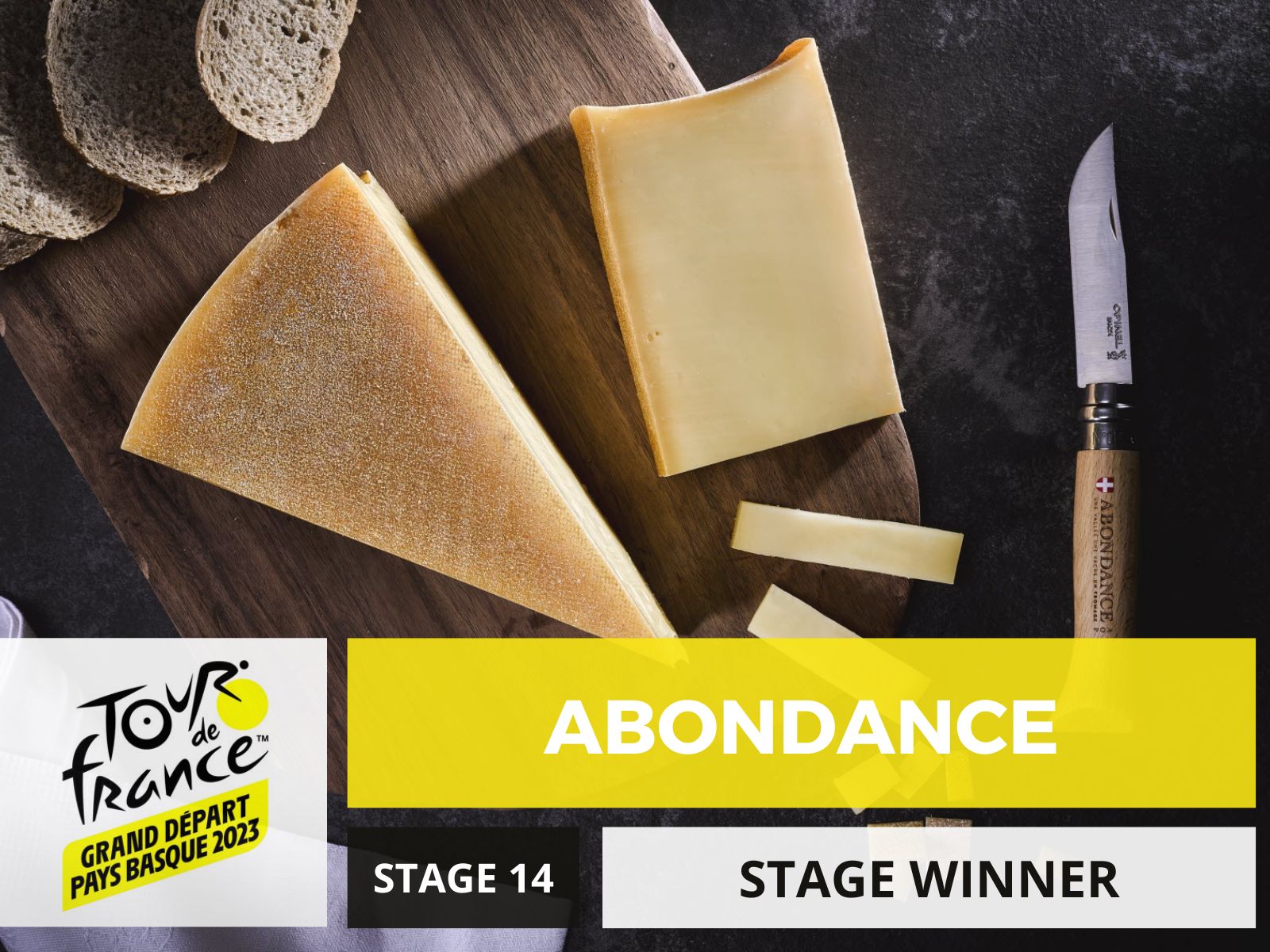
As the riders go from Annemasse to Morzine, it will be another hard day in the Alps. Stage 14 consists of four major climbs: the Col de Cou, Col du Feu, the Col de le Ramaz and Col de Joux Plane. The stage will end with a descent to Morzine, a ski resort that has hosted several Tour finishes in the past.
A short scenic drive from Morzine will get you to the picturesque commune of Abondance. Of course, this is the birthplace of the first of four Savoyard cheeses on our list, Abondance.
Abondance cheese is made from the raw milk of cows that graze on rich alpine pastures. Undoubtedly, its most recognisable feature is its flat cylindrical shape and concave edge. Actually, this pressed cheese packs quite a punch with a bold barnyard aroma and fruity, nutty and buttery flavour.
Our favourite way to enjoy this mountain cheese is to melt it in a traditional Savoyarde dish called Berthoud.
Stage 15: Les Gets Les Portes du Soleil > Saint-Gervais Mont-Blanc
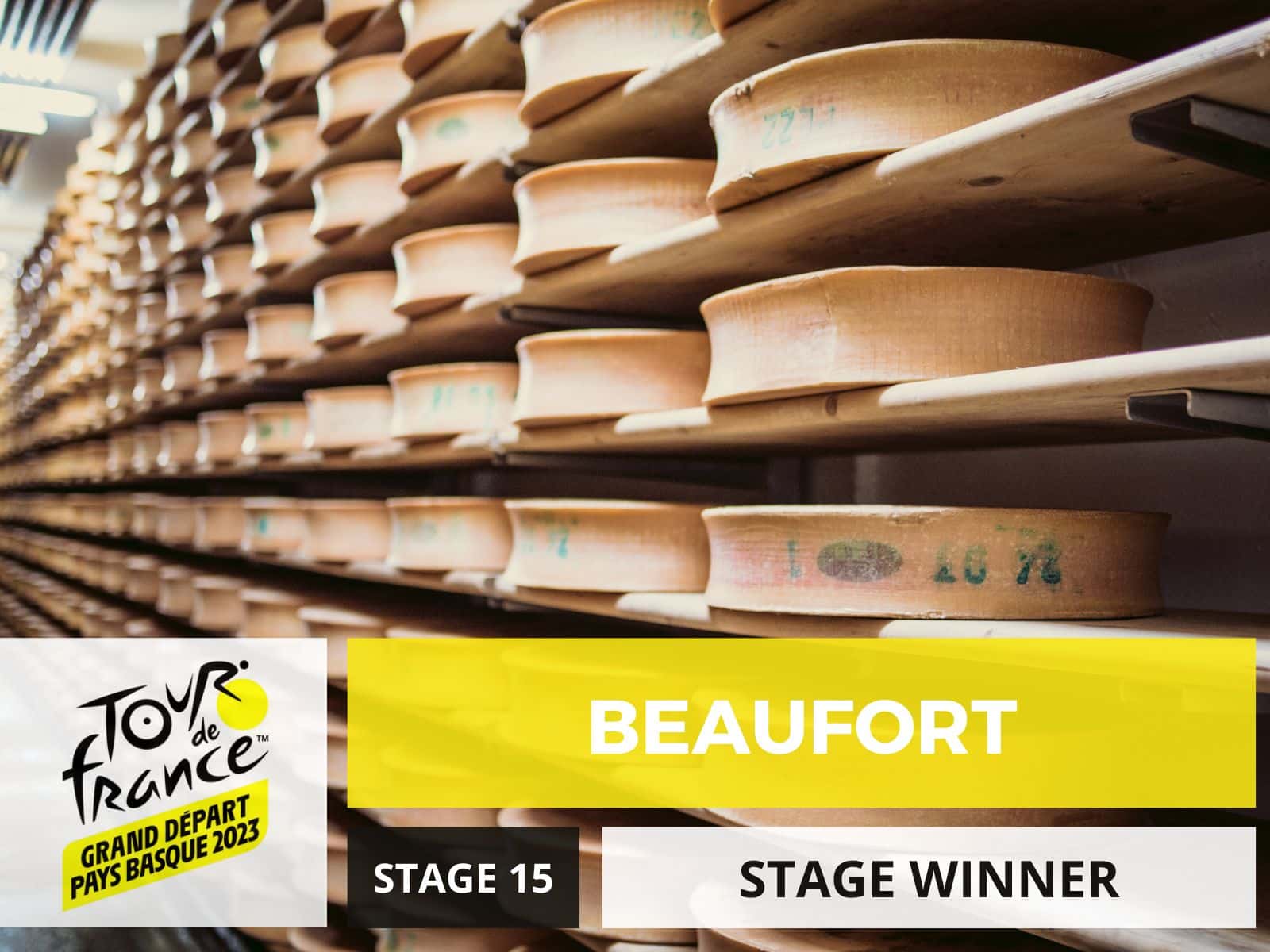
A third day in the Alps sees the riders go from Les Gets to Saint-Gervais Mont-Blanc. It will be the queen stage of the race, with four categorised climbs: Col de la Forclaz de Montmin, Col de la Croix Fry, Côte des Amerands and Saint-Gervais Mont-Blanc.
The winning cheese for Stage 15 is another classic from Savoie, Beaufort. Actually, Saint Gervais is only a 20-minute drive away from Praz-sur-Arly, an approved commune for Beaufort production.
Beaufort is made from unpasteurized cow’s milk and has a firm, creamy and smooth texture. Typically, local affineurs age their Beaufort wheels from 4 to 24 months. And the flavour varies depending on the season and the type of pasture where the cows graze.
When it comes to pairings, Beaufort cheese is best enjoyed with full-bodied white wines, such as Chardonnay or Viognier. Also, this cheese is delicious when used in Savoie’s take on Fondue.
Stage 16: Passy > Combloux
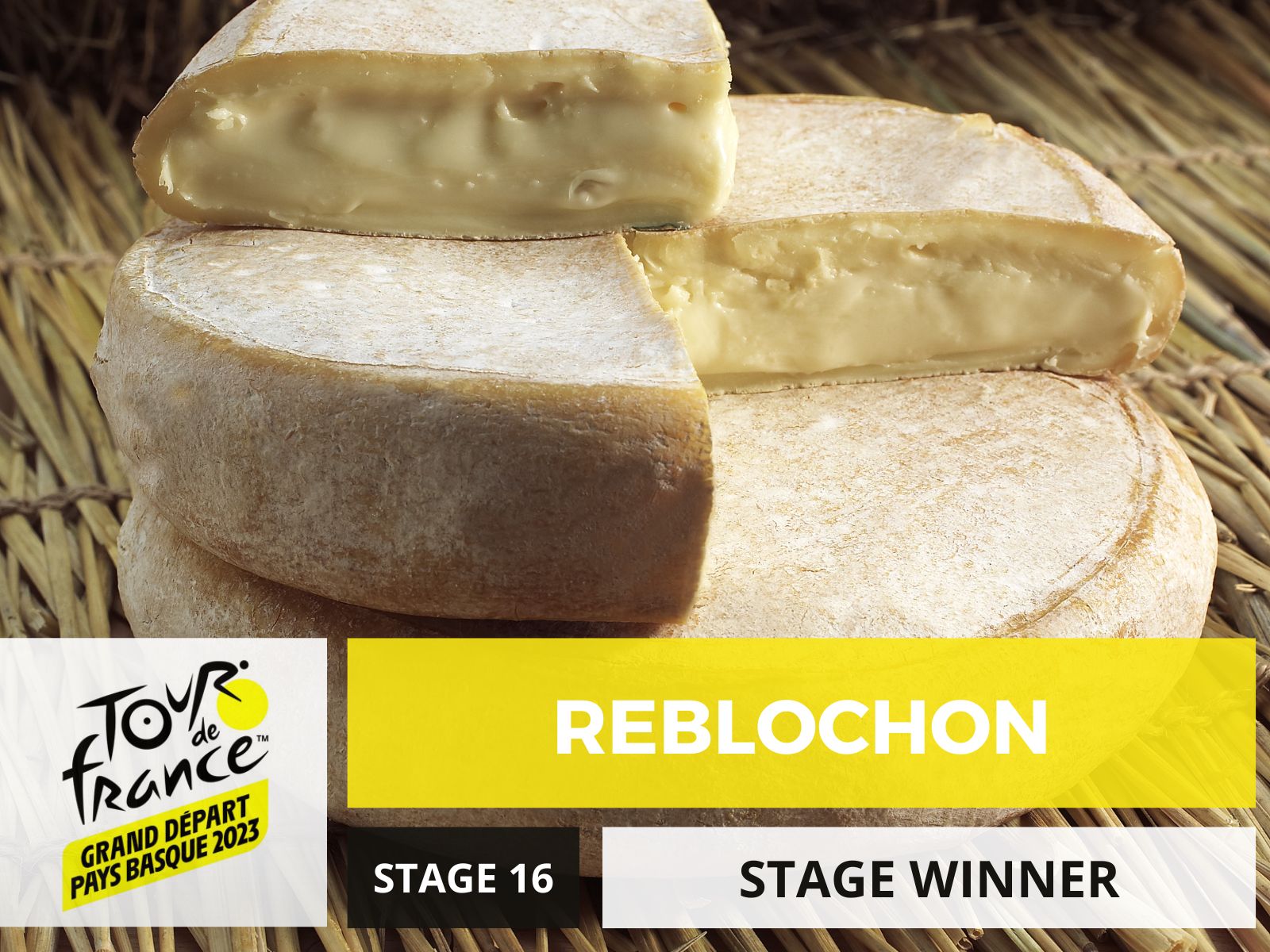
After a day’s rest, the riders will face the only time trial of the race. The stage will cover 22 km and include one categorised climb: the Côte de Domancy. The stage will finish in Combloux, a village that overlooks Mont Blanc.
The route will travel through the heart of Reblochon country. Indeed, the towns of Passy, Combloux and Sallanches are all within the approved production zone for this classic Savoyard cheese.
Reblochon is a pressed uncooked cheese with a delicate washed rind. Local artisans make it with exclusively raw milk. As it ages, the cheese develops a creamy paste and has a mild fruity flavour.
While Reblochon can be served on a cheese plate, the locals mostly enjoy it cooked in a traditional dish called Tartiflette. Tartiflette is a warming winter gratin of potatoes, bacon, onions and cheese.
Stage 17: Saint-Gervais Mont-Blanc > Courchevel
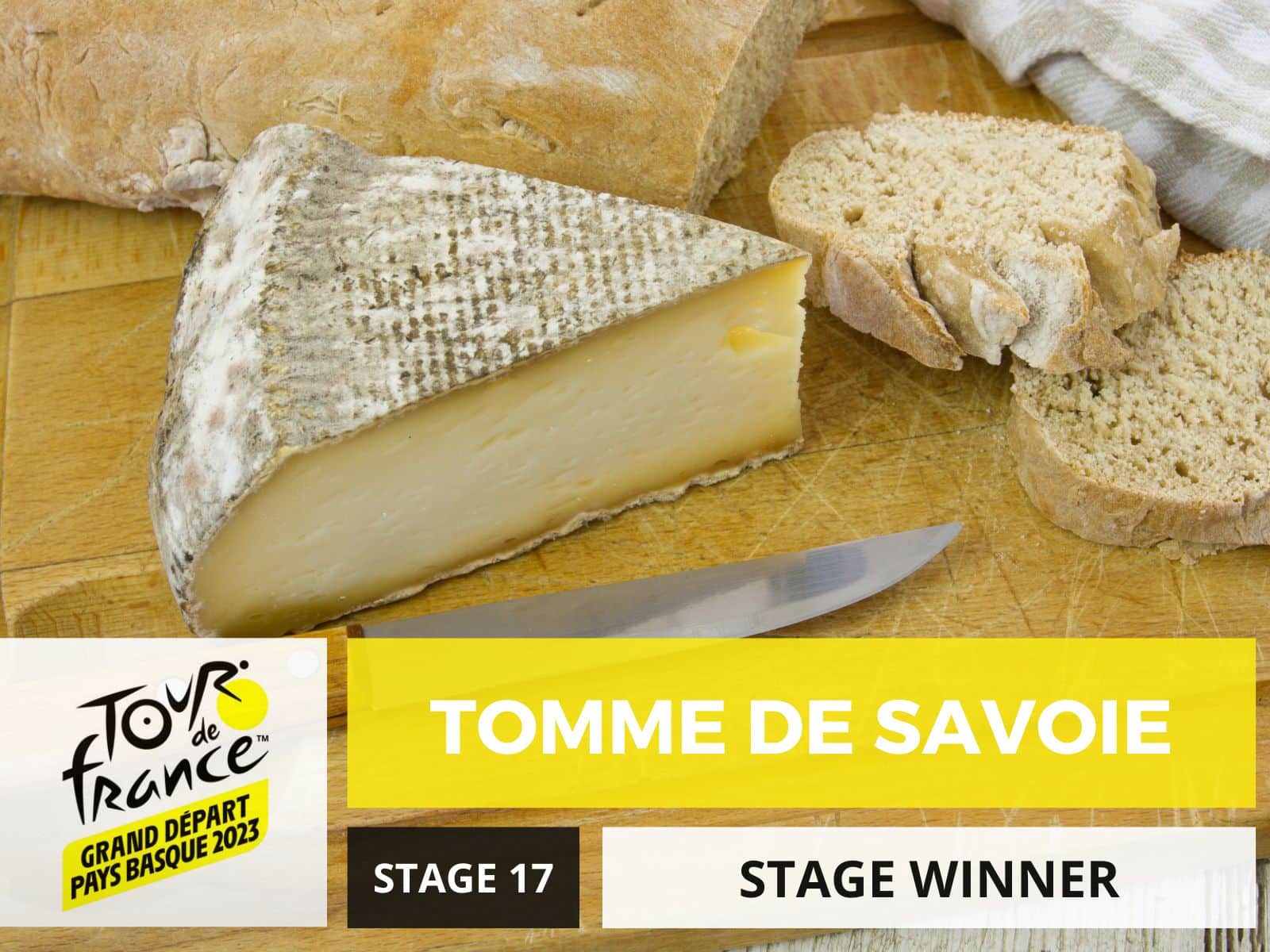
Riding from Saint-Gervais Mont-Blanc to Courchevel will be a short but intense day in the mountains. Indeed, this stage includes four climbs: Col des Saisies, Col de Roselend, Côte de Longefoy and Col de la Loze. The latter is a steep and steady climb that will favour the pure climbers. And will mark this year’s highest point in the race with the Souvenir Henri Desgrange.
Stage 17 will travel through the approved zone of production for our fourth and final cheese from Savoie, Tomme de Savoie. Unlike the first three cheeses, Tomme de Savoie does not have an AOP stamp but is still geographically protected by an IGP (Indication Géographique Protégée).
Tomme de Savoie is a semi-soft cheese that is made from raw cow’s milk. This mountain cheese has a beige paste with irregular eyes and a thick brownish-grey rind. Furthermore, Tomme de Savoie has a mild, grassy, nutty, and mushroomy flavour with a barnyardy and earthy aroma.
If you’re French, you have cheese with every meal. And, in Haute-Savoie, Tomme de Savoie is the ultimate breakfast cheese. Enjoy it sliced with a warm baguette and a hot cup of coffee.
Stage 18: Moûtiers > Bourg-en-Bresse
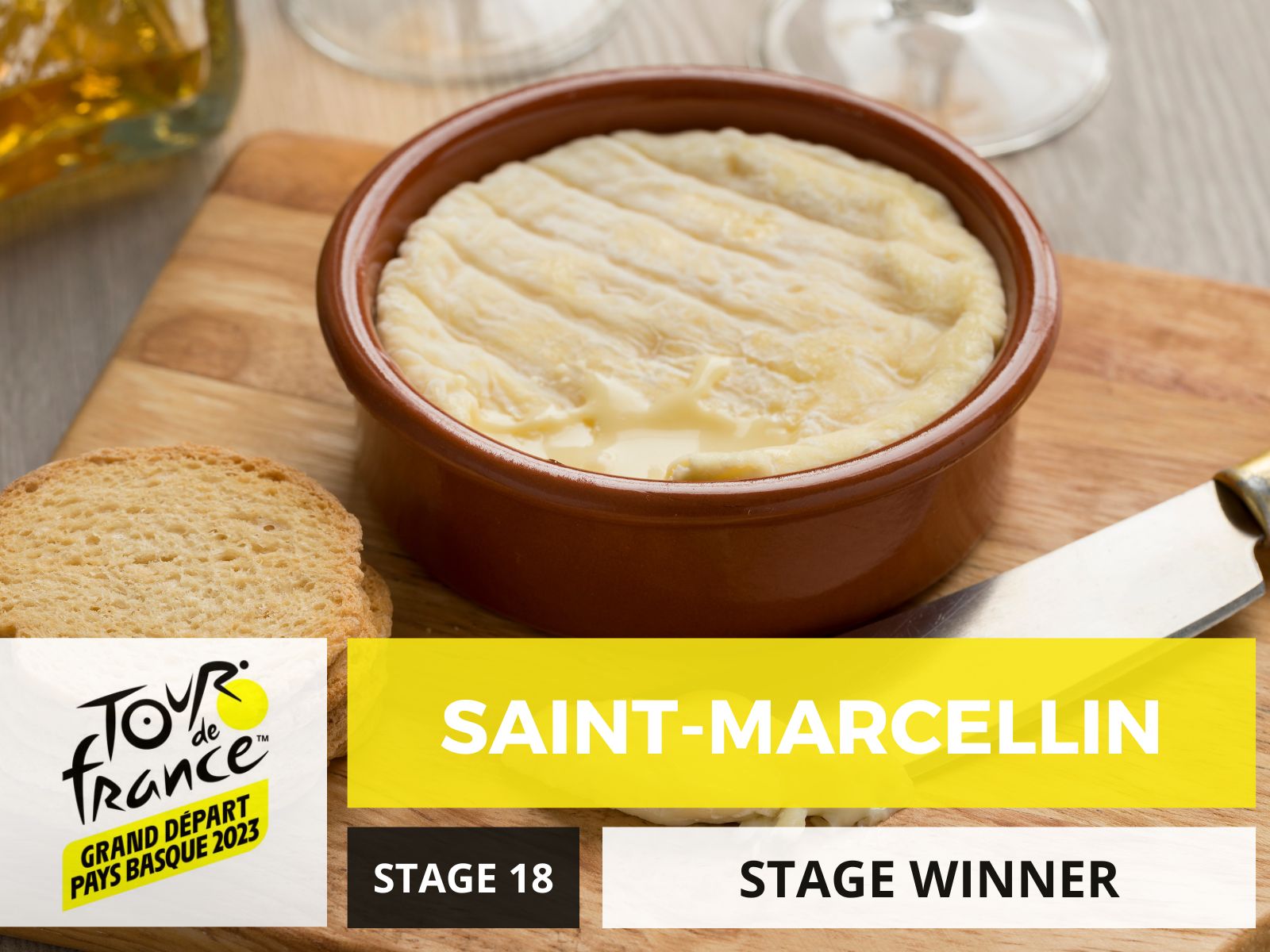
This hilly stage will be a transitional day that will take the riders from the Alps to the Jura. The stage will have some rolling hills and a few short climbs, but nothing too demanding for the GC contenders.
During Stage 18, the riders will travel through the zone of production of another IGP cheese, Saint-Marcellin.
Saint-Marcellin is a soft white mould cheese that is made from cow’s milk in the Isère region. It has a creamy and fluffy texture with a white paste and a wrinkly rind. Moreover, its flavour is mild, fruity and nutty with a pleasant aroma.
In this part of France, you can buy a ripe version of this cheese in a small terracotta dish. Without a doubt, the best way to enjoy Saint-Marcellin is to spread it on a warm crunchy baguette.
Stage 19: Moirans-en-Montagne > Poligny
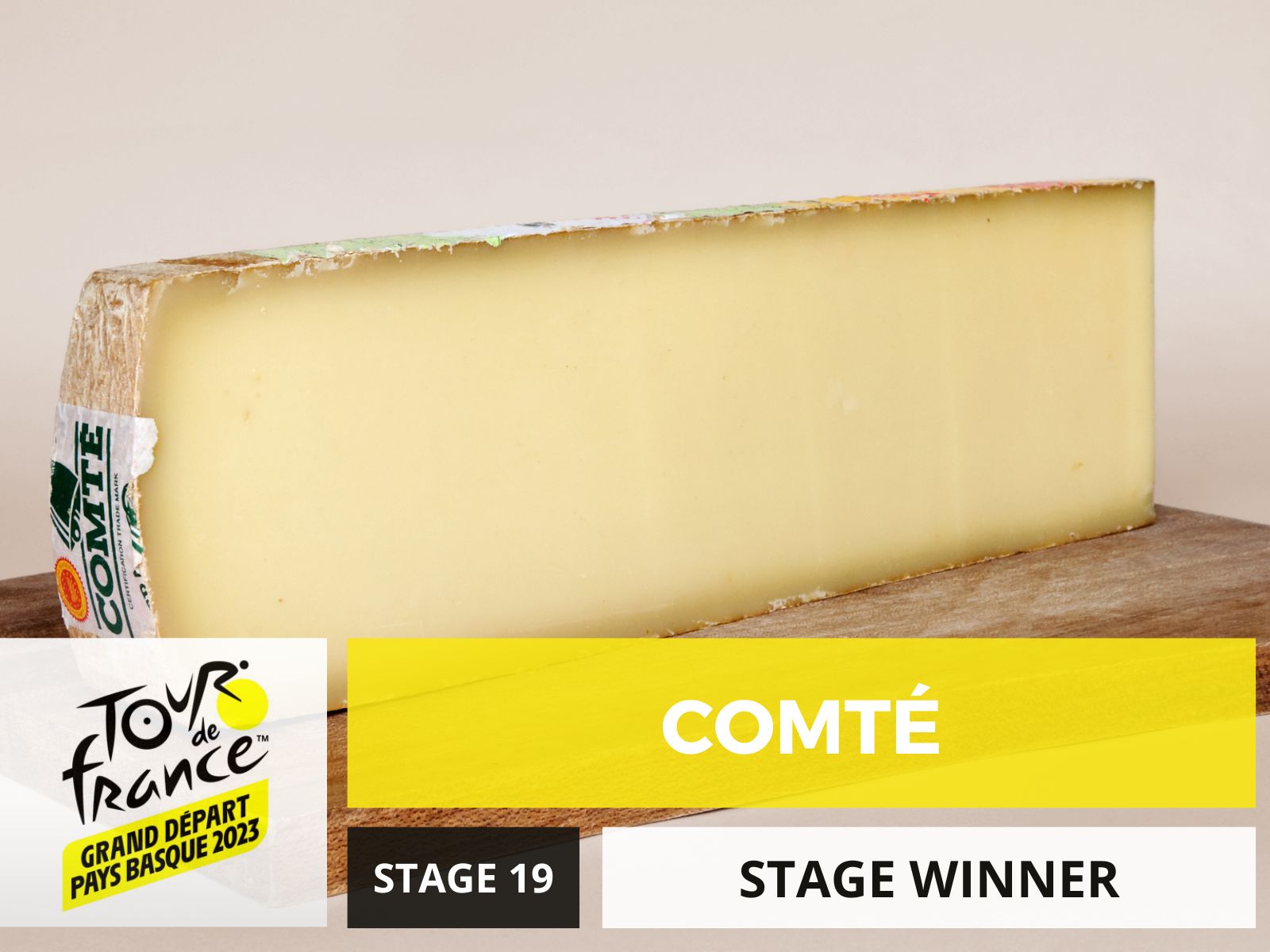
This flat stage starts from Moirans-en-Montagne, a town known for its wooden toy museum, and finishes in Poligny. It should be a relaxed day for the peloton before the final showdown in the mountains.
The ville d’arrivée is famous for its cheesemaking academy and La Maison du Comté. So, we have a clear winner for this stage: Comté!
Comté is a pressed cheese made from unpasteurized cow’s milk. The raw milk comes mainly from Montbéliarde or French Simmental cows, that graze on rich, diverse pastures. Comté cheese has a nutty, buttery and fruity flavour that varies depending on the season and the ageing time.
Comté pairs well with white wines, such as Chardonnay or Jura, or red wines, such as Pinot Noir or Beaujolais. It can also be served with bread, fruit, nuts and honey.
Stage 20: Belfort > Le Markstein Fellering
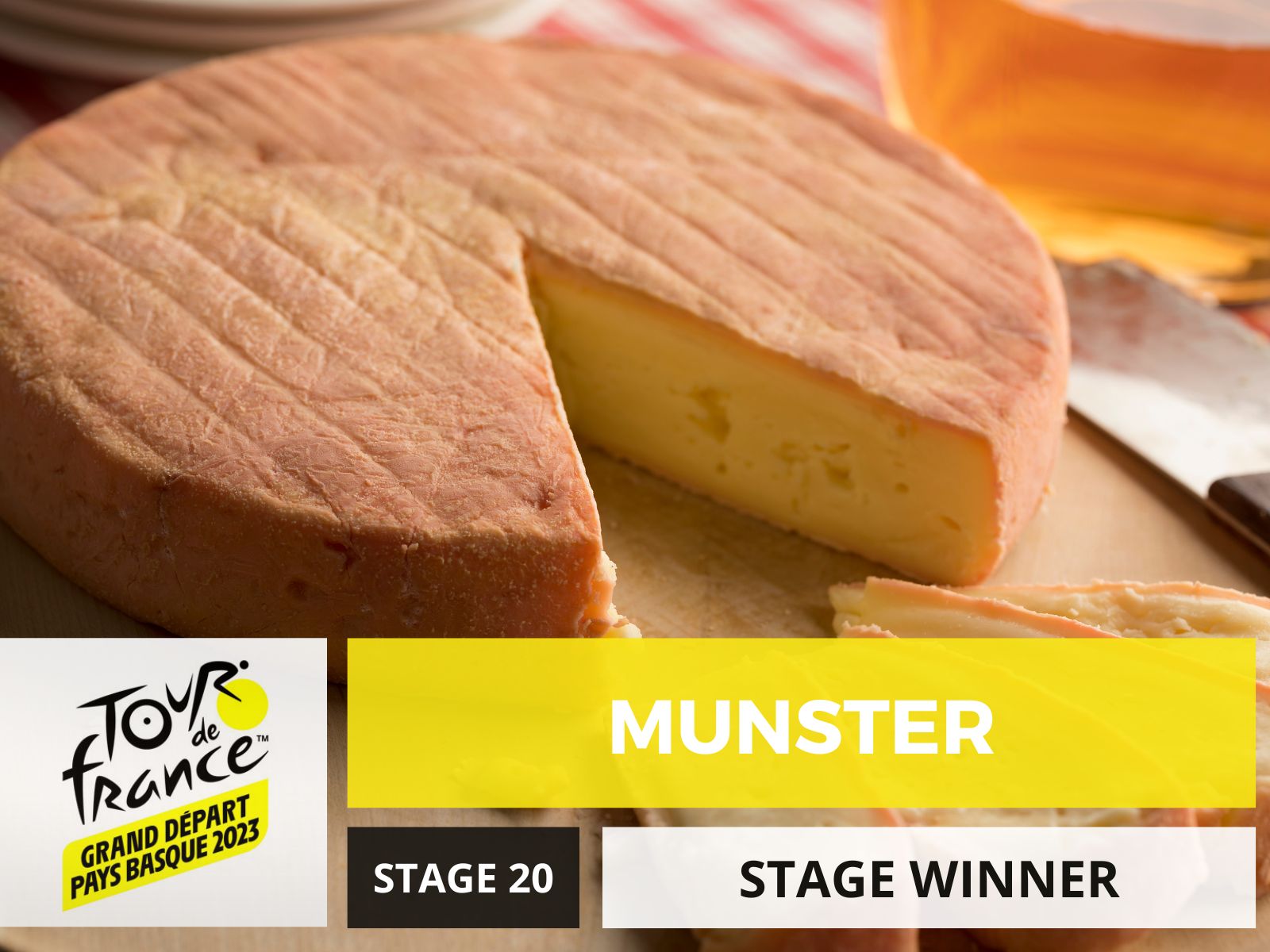
This medium mountain stage will present one last chance for the climbers to make a difference in the GC. Indeed, it will feature five climbs: Ballon d’Alsace, Col de la Croix des Moinats, Col de Grosse Pierre, Petit Ballon and Col du Platzerwasel.
When you think of Alsace and the Vosges, there is one cheese that always stands tall. And that is Munster!
Munster is a soft washed rind cheese that is made from cow’s milk in the Vosges region. Without a doubt, it is one of France’s most robust smelling cheeses. However, its flavour is still quite mild and savoury, with hints of beef broth and yeast.
Like most robust washed rind cheeses, Munster pairs well with bold wines such as Gewurztraminer. You can also enjoy it with a pint of Belgian Brown Ale.
Stage 21: Saint-Quentin-en-Yvelines > Paris Champs-Élysées
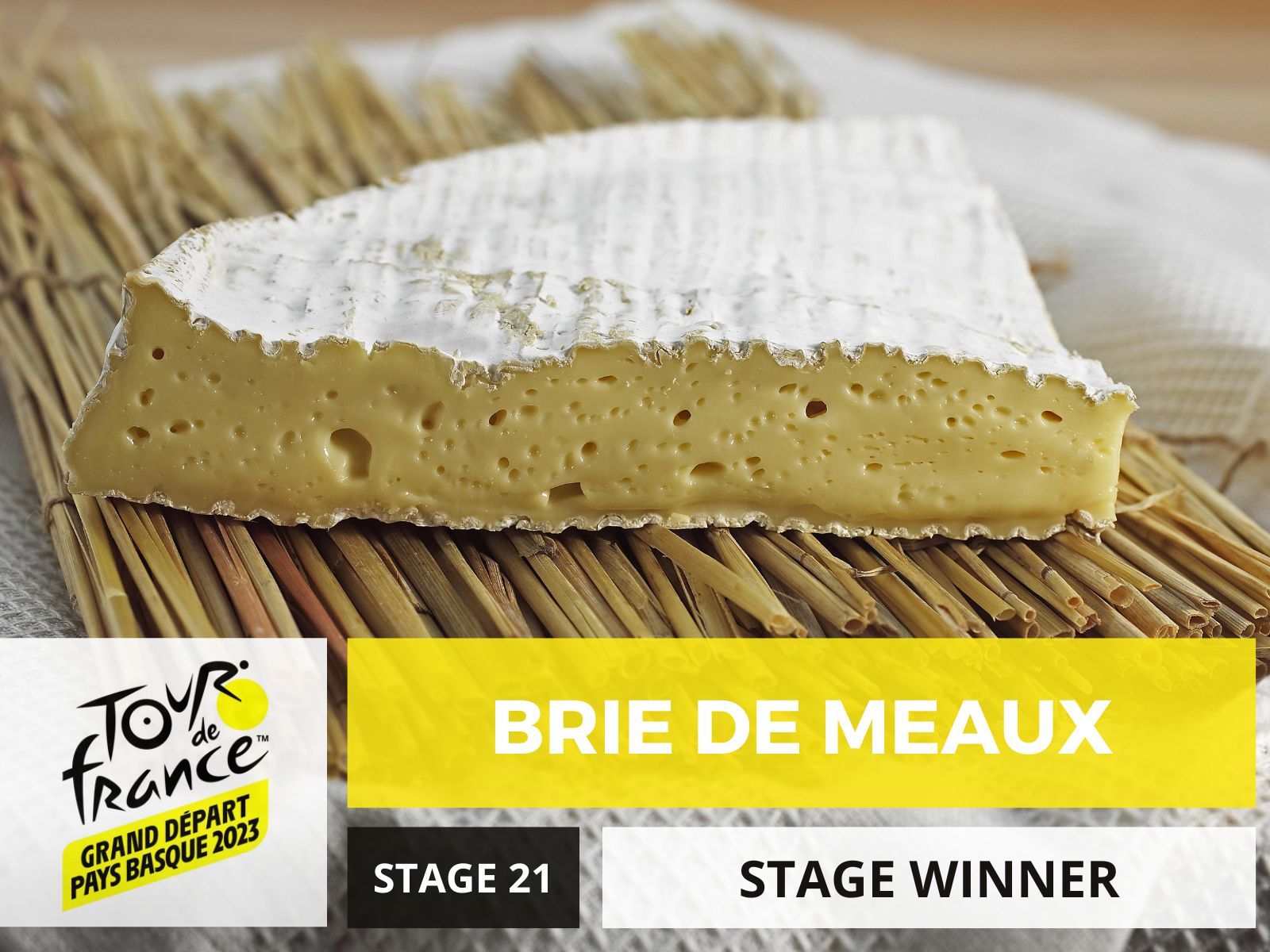
As always, the final stage of Le Tour will cross the finish line on the Champs-Élysées. It will be the traditional finale of the Tour, with a festive atmosphere and, most likely, a sprint on the most famous avenue in the world. The stage will pass through some of the most iconic landmarks of Paris, such as the Eiffel Tower, the Arc de Triomphe and the Louvre.
During the stage, the procession will go through the Hauts-de-Seine department. This part of Île-de-France is home to one of France’s most famous cheeses, Brie de Meaux.
While Brie is not a protected name in the European Union, there are two French Brie cheeses that bear an AOP stamp. Those are Brie de Melun and Brie de Meaux. The latter is a raw cow milk cheese originating from Meaux in the historical region of Brie. It has a white mould rind, a creamy paste and buttery flavour with notes of mushroom.
This wonderful soft cheese has so much depth of flavour that it can be served on its own. The rind is edible and is packed with flavour. So, don’t leave it behind! If you do want to add some pairings, a warm crunchy baguette is a good starting point. As for beverages, choose a fresh white wine like Chardonnay or Chinon. And be sure to avoid red wines!
Where will you be watching the Tour de France from in 2023?
Thank you for reading our cheese lover’s guide to the Tour de France 2023. Where will you be watching the tour from this year? Will you be on the side of the road? Or glued to your TV screen even at ungodly hours? Let me know in the comments.
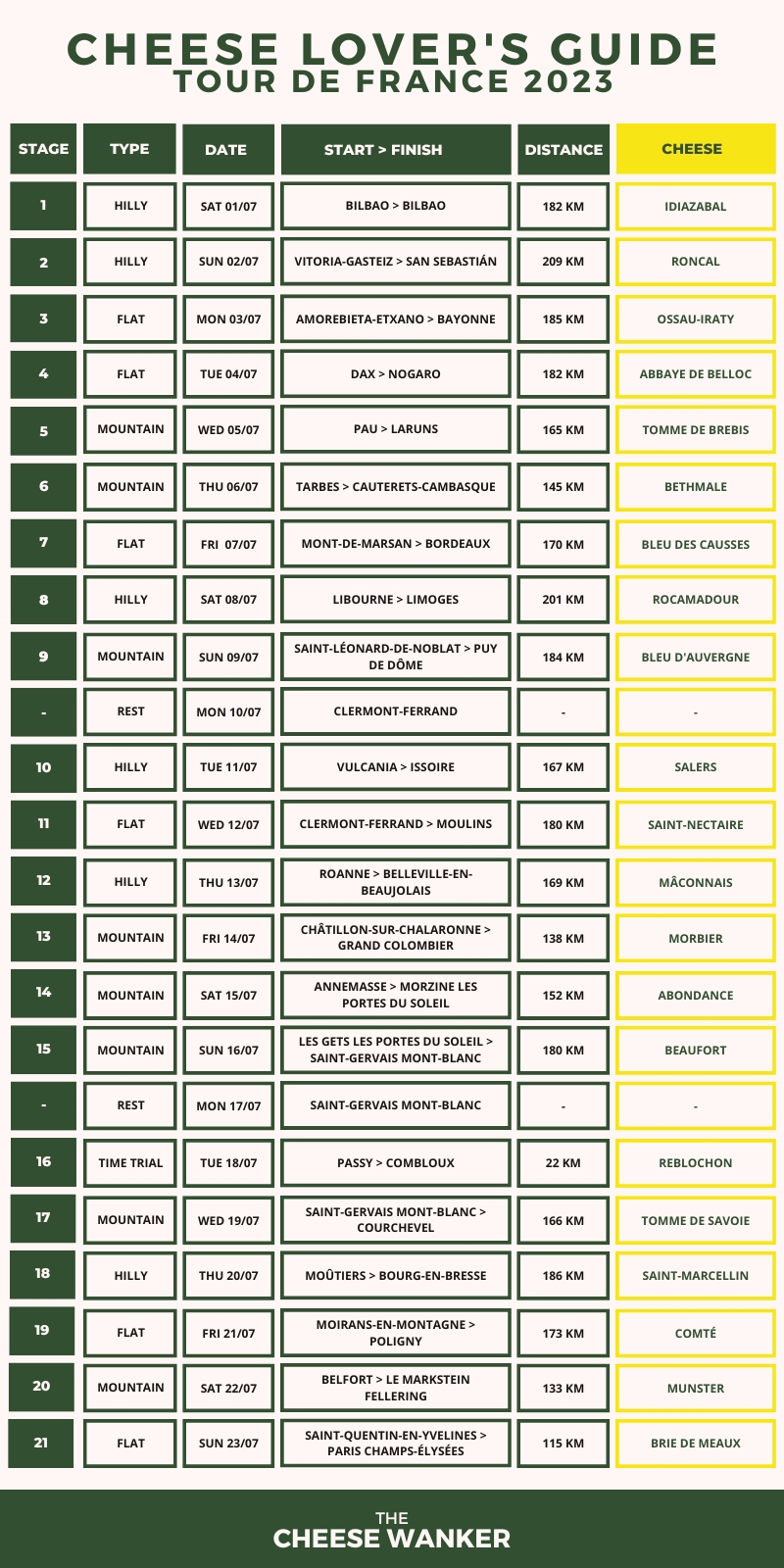
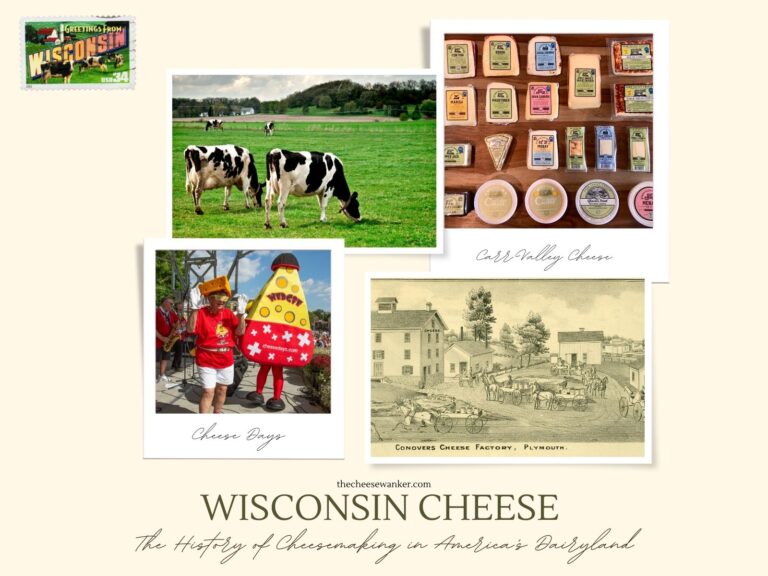

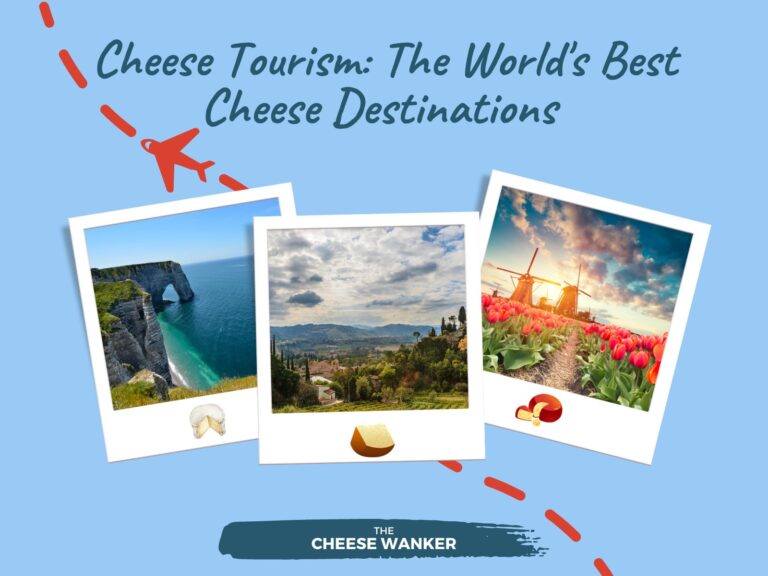
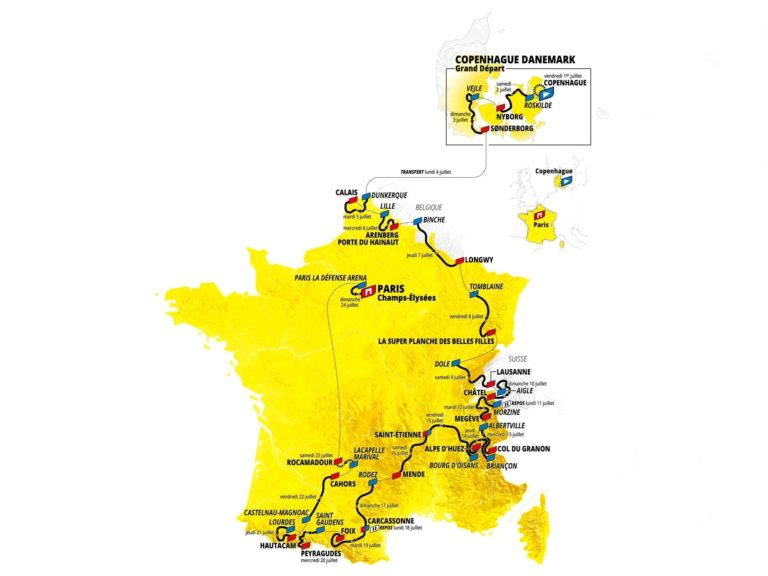
Very thankful for sharing this immense knowledge of the different places in France and the cheese one can taste at each stop. 👌